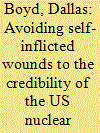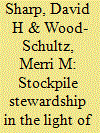| Srl | Item |
| 1 |
ID:
166865


|
|
|
|
|
| Summary/Abstract |
Nuclear deterrence requires not only the reliability of a state’s strategic weapons and the willingness of its leaders to employ them but also an adversary’s appreciation of these conditions. Weapons perceived as failing to hold their targets at risk may lack deterrent value, just as retaliatory threats that are not believable may fail to deter, even if a state’s operational capabilities are robust. Both the technical and political credibility of the US nuclear deterrent may have suffered self-inflicted harm since the end of the Cold War, often as casualties of intemperate policy debates. In particular, doubts have been sowed about the reliability of aging US warheads under a science-based stockpile-stewardship regime meant to substitute for nuclear-explosive testing. Likewise, the credibility of US deterrent threats may have waned as American leaders have spoken ever more stridently about the horrors of nuclear war and nuclear terrorism, underscoring their extreme aversion to the risk of nuclear attack. Diminished credibility in both spheres threatens to compromise US national-security objectives ranging from nuclear nonproliferation to the outcomes of nuclear crises.
|
|
|
|
|
|
|
|
|
|
|
|
|
|
|
|
| 2 |
ID:
156930


|
|
|
|
|
| Summary/Abstract |
Uncontrolled risk is inherent in any program that lacks a proven means for revealing improper system performance, and the U.S. Stockpile Stewardship Program (SSP) is no exception. The downside of uncontrolled risk has been illustrated by the outcome of the National Ignition Campaign (NIC), a part of the Inertial Confinement Fusion (ICF) Program that has long been characterized as a crucial adjunct to the U.S. nuclear weapons program. For most of its duration, the NIC utilized simulations and partial-system experiments at several facilities, adding full-system experiments at the National Ignition Facility (NIF) only at the very end of the program. Uncontrolled risk was present in the program while those experiments were absent. That risk materialized when failure to achieve fusion capsule ignition was repeatedly and conclusively demonstrated in full-system experiments. For the SSP, the corresponding risk is that expectations concerning the safety, performance, and reliability of weapons in the stockpile are significantly incorrect. The only proven way of controlling that risk—finding out whether the expectations are wrong—requires nuclear testing. In its absence, this risk is not controlled by the SSP. The ongoing presence of uncontrolled risk in the U.S. nuclear stockpile leads inevitably to uncertainty in the effectiveness of the U.S. nuclear deterrent. None of the potential consequences of that uncertainty, one of which is a decrease in the deterrent's effectiveness, are beneficial to the United States or those who rely on its nuclear umbrella.
|
|
|
|
|
|
|
|
|
|
|
|
|
|
|
|